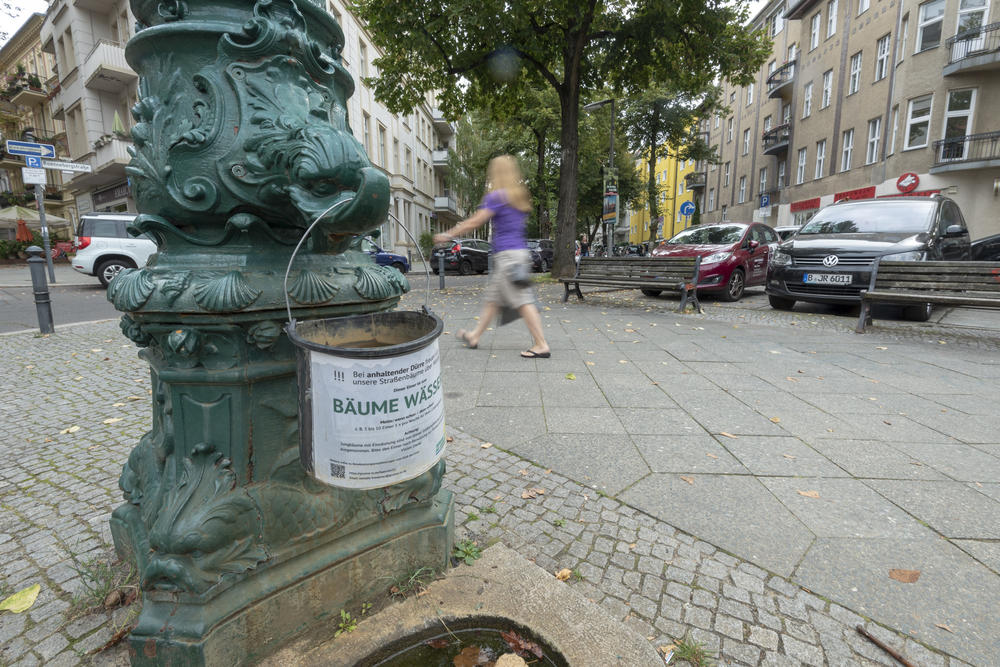Volunteer Fire Brigade for the Climate
The Environmental Policy Research Centre at Freie Universität supports small towns in taking measures to adapt to climate change
Nov 17, 2021
Please help water the trees! In hot summers, the trees in cities are under great danger.
Image Credit: Bernd Wannenmacher
One sign of climate change is when something terrrible happens every summer. In 2018 there were no dramatic images of floods as there were in 2021, but a heat wave had drastic consequences: according to a study published in the medical journal The Lancet, more than 20,000 people over the age of 65 died in Germany as a result of the heat in 2018.
We do not need to wait until 2050 to experience an increase in hot days or floods. The impacts of climate change are already tangible, and we urgently need measures for adapting. How can entire cities with their buildings, streets, and green spaces be modified so that they are better prepared for the challenges posed by climate change? How can municipalities, districts, and states assess and make decisions about which measures are worthwhile and how scarce resources can best be used?
Keeping a Cool Head when Things Get Hot
Dr. Klaus Jacob, a research director at the Environmental Policy Research Centre at Freie Universität Berlin, designed the project GoingVis – Keeping a cool head in hot times. It is intended to help small towns in Germany take measures to better adapt to climate change.
“GoingVis” is based on the premise that although the political institutions in Germany have drawn up important strategies such as the German Adaptation Strategy to Climate Change (DAS), these are often not yet sufficiently effective. As Dr. Jacob points out, “Particularly in peripheral small towns, there is often not enough administrative capacity to develop an overall concept for climate adaptation measures.” There is often even a lack of staff to handle the “normal” day-to-day administration. In most cases there are no local research institutions to provide scientific know-how.
Because the administrations of small towns often cannot do it alone, Klaus Jacob, together with political scientist Nicole Mitchell and others, has developed an approach that includes civil society. In this approach, the citizens and the municipal administrations work together. Thus, a city can become better prepared to deal with increasing heat and drought, while also becoming more comfortable for its citizens at the same time.
Nicole Mitchell points out that in the debate about climate change adaptation in large cities, the focus is on designing cities through urban planning and architecture to avoid the heat island effect, i.e., the effect that causes cities to be hotter in the summer than outlying areas. This occurs because the air cannot circulate, buildings and road surfaces store heat, and there are no trees to provide shade and evaporation.
What Helps against Heat? Planting and Watering Trees
Very simple measures such as planting trees or changing watering schedules can contribute to reducing the impact of heat and increasing the feeling of well-being in cities. These measures can help preserve existing green spaces and trees.
Many people may have already seen this image on social media: A picture of a road in midsummer with temperature readings that highlight the stark differences that exist between a tree-shaded road and pure asphalt. The trees not only filter the air and convert carbon dioxide into oxygen; they also act like air conditioning for the outside and can cool the temperature by up to four degrees Celsius. In other words, they can save lives when the next heatwave hits the city.
Helping Shape the City
As a first approach, researchers in the collaborative project “GoingVis” try to understand what special features apply to small cities. For example, in Boizenburg an der Elbe, one of the two partner cities of the GoingVis project, Mitchell and Jacob first organized a “future workshop.” In order to initiate the joint development of adaptation activities based on urban society, they invited schoolchildren as well as senior citizens, sports clubs and allotment gardeners, political groups and randomly selected citizens to participate.
Nicole Mitchell says about the workshop, “People didn’t necessarily respond to the challenge of climate change or heat adaptation, but rather to the question: How can we participate in the design of our city and make it more livable? How can we maintain or even improve the quality of life in our city despite climate change?”
Klaus Jacob added that this soon opened up many opportunities for the citizens themselves to “take the reins of action and say: We are now taking care of the green spaces, the design of the city park, or the shading and greening of bus stops.”
Voluntary Fire Department for Climate Change
Dr. Jacob stresses that the scientists do not intend to push the tasks of the city government or the public administration onto the citizens. However, he observes an exciting dynamic: “The insight that something has to be done in terms of climate adaptation is linked to the realization that the city administration, as it is set up, cannot do it. Moreover, at the same time this is related to the search for social cohesion. That opens up new potential, and people really enjoy working on it together.”
It is almost like a volunteer fire department for climate protection: Except that you do not put out fires, you decide to re-naturalize a river, or to build a water playground to cool off in the coming heat.
This text originally appeared in German on October 2, 2021, in the Tagesspiegel newspaper supplement published by Freie Universität Berlin.
Further Information
- Dr. Klaus Jacob, Environmental Policy Research Centre at Freie Universität (FFU), Email: jacob@zedat.fu-berlin.de
- GoingVis – Keeping a cool head in hot times
- Project website: www.goingvis.de and www.goingvis.de/about-english/

